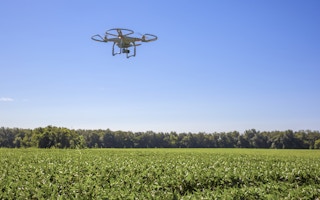In the not-so-distant future, my Amazon package would have arrived courtesy of a drone, but today it was left in the porch by a UPS driver. A rip of the cardboard zip disgorged four books for the rapidly expanding Volans library on exponentially different futures. Among them, and alongside yet another copy of Salim Ismail’s Exponential Organizations (replacing the one I left on a plane and a Kindle version I found impossible to read), was Adrian Hon’s extraordinary book, A History of the Future in 100 Objects.
I have long been fascinated by the way some objects come to represent a vital slice of our collective history. A couple of blocks from our London office stands the British Museum, its vast holdings including the Rosetta Stone, the most-visited object—and my own personal favorite. Few objects better capture the essence of what I have tried to do in life than this granite stele, which helped decode hitherto inscrutable Egyptian hieroglyphs. But a figment of Douglas Adams’ imagination has also served me well. He described the Babel Fish thus:
“The Babel Fish is small, yellow, leech-like, and probably the oddest thing in the universe. It feeds on brain wave energy, absorbing all unconscious frequencies and then excreting telepathically a matrix formed from the conscious frequencies and nerve signals picked up from the speech centres of the brain, the practical upshot of which is that if you stick one in your ear, you can instantly understand anything said to you in any form of language ….”
For years, we used the Babel Fish as a symbol for what several organizations I had co-founded were attempting as they bridged between business and wider society, between present and future realities. True, our translation function was embryonic compared with that Adams claimed for the Babel Fish, but we did help business and a growing universe of stakeholders to get a better grip on how capitalism can create new forms of value across sustainability’s triple bottom line.
But success brings new problems, particularly where people saw the triple bottom line as a balancing act rather than an invitation to break through. I became increasingly anxious, as evidenced in our Breakthrough work, that as our agenda mainstreams it risks heavy dilution—skewing toward incremental outcomes rather than systemic change. Happily, however, 2015 ended with strong indications that the system change agenda is gaining momentum.
In December alone we co-convened the first in a planned series of convenings alongside the Academy for Systemic Change and Finance Innovation Lab. Then I flew to Amsterdam for a gathering of like-minded people planning a new organization dedicated to system change. But perhaps most exciting of all, Volans reached agreement with the United Nations Global Compact to co-evolve our Breakthrough Program over the next two years, focusing on exponential solutions to the challenges spotlighted by the UN Sustainable Development Goals and COP21 climate summit.
Our focus will be on tomorrow’s market insurgents and revolutionaries, at a time when most corporate members of B2B platforms like the Global Compact and World Business Council for Sustainable Development still represent the incumbents in an old, unsustainable economic order.
Disruptive change is coming—and will accelerate. The third book in my Amazon package forecasts the Clean Disruption of Energy and Transportation, with the telling sub-title ‘How Silicon Valley will make oil, nuclear, natural gas, coal, electric utilities and conventional cars obsolete by 2030’.
“
I became increasingly anxious, as evidenced in our Breakthrough work, that as our agenda mainstreams it risks heavy dilution—skewing toward incremental outcomes rather than systemic change.
A key conclusion: “The age of centralized, command-and-control, extraction-resource-based energy sources (oil, gas, coal and nuclear) will not end because we run out of petroleum, natural gas, coal, or uranium. It will end because these energy sources, the business models they employ, and the products that sustain them will be disrupted by superior technologies, product architectures, and business models.”
But there is bad news, too. The fourth book was James Barrat’s Our Final Invention, published several years back—arguing that Artificial Intelligence will bring an end to the human era as we are forced to compete with “a rival more cunning, more powerful and more alien than we can imagine.”
So what object might we choose to symbolize disruptive progress toward a more sustainable future? There are choices aplenty in A History of the Future in 100 Objects, modelled on a book by Neil MacGregor, a former director of the British Museum. On page 81, for example, the twenty-ninth future-encoding object is the ‘Curve of Babel’.
This is a sculpture inscribed with phrases from 539 languages, terms picked because they are almost impossible for even advanced AI to translate. Still, by the time the sculpture is erected AI has spawned technologies enabling anyone to understand what others say in almost any language. Counter-intuitively, instead of driving weaker languages into extinction, this helps even nano-minority languages find a place in the global economy.
But if I had to pick just one of the 100 future objects, it would come from the story of Mohsen Rohimi, told on pages 166-168. He finds himself trapped by an incoming swarm of end-of-life drones, programmed to present themselves for disassembly and recycling. Drones have been one of the biggest tech stories recently—underscoring how new technology can bring both huge upsides and unexpected downsides, as when drones invade our privacy or disrupt flight lanes.
But to end on a positive note, a tweet that caught my imagination over the holidays came from the Atlas of the Future—flagging the ambitious plans of former NASA engineer Lauren Fletcher to use quad-copter drones to plant up to a billion trees a year. His modest motto: “Changing the world … 1 billion trees at a time.” That’s breakthrough thinking, whatever language we use to describe it.
John Elkington is chairman & chief pollinator at Volans.
To continue reading, subscribe to Eco‑Business.
There's something for everyone. We offer a range of subscription plans.
- Access our stories and receive our Insights Weekly newsletter with the free EB Member plan.
- Unlock unlimited access to our content and archive with EB Circle.
- Publish your content with EB Premium.











